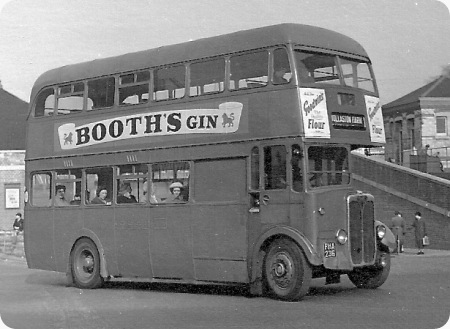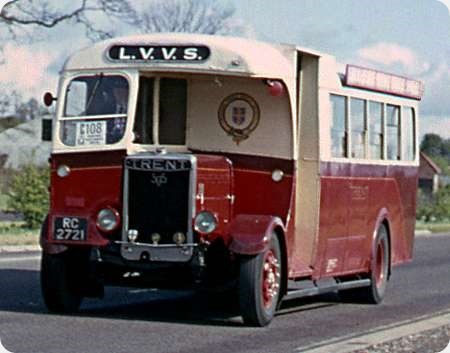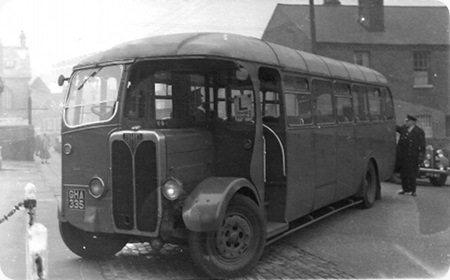
Photograph by ‘unknown’ if you took this photo please go to the copyright page.
Midland Red (Birmingham & Midland Omnibus Co)
1939
SOS FEDD
Brush H30/26F
Midland Red FHA 236 (2254, formerly 236) was one of their unique pre-war, front-entrance, SOS FEDD double-deckers. They were built in large numbers between 1933 until 1939 with bodies by Carlyle (1), Short Bros, Metro-Cammell and finally Brush, each batch having gradual improvements and modifications. Like their SON single-deck sisters, they were extensively rebuilt by Hooton Aero & Engineering (and others?) in the 1940s to extend their lives. This example is seen at Stourbridge bus station, probably in the late 1950s. Note the position of the fuel cap, which fed the tank positioned beneath the driver’s seat. This postcard is uncredited so if anyone knows who took it, please let us know.
station, probably in the late 1950s. Note the position of the fuel cap, which fed the tank positioned beneath the driver’s seat. This postcard is uncredited so if anyone knows who took it, please let us know.
Photograph and Copy contributed by Paul Haywood
10/07/12 – 18:28
It’s interesting how this forward entrance layout, used extensively pre-war by Barton and London Country area as well as Midland Red died out in the post-war period only to find popularity again in the early 1960’s. The reasons cited for the adoption of forward entrances in the sixties were greater safety by giving the driver a better view of the entrance and easing the conductor’s workload as a result particularly on 30ft long higher capacity vehicles.
Philip Halstead
11/07/12 – 08:05
Looking at this, and at the single decker posted a few days ago, without looking at the caption, the radiator grille looks remarkably AEC, at first glance. Then, you study it and see it isn’t!
Pete Davies
11/07/12 – 08:06
Dare I say, that surely must be one of the most awkward looking designs imaginable. What strange proportions giving it a very "tall" appearance and the design around the cab is very unhappy. Even the radiator looks partly buried by the flat, featureless front.
Thank goodness this was only a blip in inspiration before coming up with many superb designs not long afterwards!
I hope this doesn’t upset anyone but beauty really is in the eye of the beholder..this poor bus needed help!
Richard Leaman
11/07/12 – 12:38
You’re absolutely right, Richard, on both the points you make: first, I agree with you that the overall design just doesn’t work. The whole of the cab area is untidy; the staircase gives the impression that the front offside passenger window has just been blocked off. The ‘tall’ appearance is possibly due to the angle of the photo, but you’re right about the radiator, the location of the front registration plate exaggerates the problem, and the livery doesn’t help either.
However, as you also remark, beauty is in the eye of the beholder; unlike many correspondents, I always thought the (much later, of course), Orion looked balanced and business like, (especially on M&D’s Guys), but at the time, the message I was being taught was that appearance is secondary to operational performance any way. An ugly duckling that was economical and reliable was preferable to a good looker that wasn’t.
The choice of entrance location, (Philip’s comment), is worth an entire separate article of its own. For urban working, there was a lot to be said, (before H&S concerns), for open platforms – quick, convenient for passengers, and, provided the driver was using his mirrors as he should, tolerably safe. Doors were less draughty for inter-urban use, but manually operated doors, especially rear doors such as Lodekkas had, were a drag for the conductor otherwise and were usually left open. In moving to front entrances, I think some operators – e.g Southdown with its Queen Marys – were motivated partly just by a desire to demonstrate their modernity; officially, the conductor remained responsible for giving the ‘go’ bell however busy. Personally, I never understood why operators chose rear or centre entrances on underfloor single deckers intended for stage carriage work.
Roy Burke
11/07/12 – 18:43
Although it wasn’t my favourite, I agree with Roy that the Orion – in the right livery – could still look good. [M & D, Sheffield and St Helens being three examples.] …..but ideally have a good looking, attractive vehicle that is also reliable and economic – in that order.
Am I the only one [ducks low to avoid flying missiles] that wasn’t over impressed with looks of BMMO buses? I have a thing about balanced designs and BMMO were, to say the least, quirky and original – and early Ds (1 – 5 especially) always seemed to be a cross between Clement Freud and Eyor; mournful and unhappy. […..or is now a good time to leave the country?]
David Oldfield
11/07/12 – 18:44
While the body, as a whole, is not unattractive, the detail is very deleterious to the overall effect. Although I’m no lover of sliding windows, the arrangement of these is bizarre. It’s also mean upstairs, in such a smoking era! The driving cab windows are so small as to be useless to a driver looking out, and the front/rear side ones are non-standard lengths! At least both headlamps are the same height!
I wonder if these FHA’s had the same entrances as the earlier EHA’s, whereby the (wooden?) doors were inset and there were two steps to climb before going through said doors. I recall the latter when I was based at RAF Stafford in 1956-58. My abiding memory of BMMO at this time was the sole bus (usually a D7), which ran through the Sunday night/Monday morning from Stafford railway station the RAF Stafford. This service must have broken records for overloading, with folk standing downstairs and upstairs and sometimes three to a seat! Bends were taken very gingerly, but with no guarantee that the vehicle would right itself then! If the bus wasn’t waiting, we’d take one of the pre-war Rolls-Royce taxis which held about 7-8 and were more than capable of 70mph, even at 20+ years old and God knows how many miles on the clock! When these beauties were replaced by Vauxhall Wyverns, my last journey from camp to station involved a driver who remained in top gear for the whole journey into town, slipping the clutch with expertise when crawling through traffic – such consummate abuse! But I digress!
Chris Hebbron
11/07/12 – 18:45
This vehicle remained in service until 1960 and was one of the final 6 withdrawn in December 1960. Two sister FEDD’s – 2120 and 2247 – continued as staff and training buses, I wonder how many miles they covered in their lifetime? I vividly remember as a youngster going ‘long distance’ with my parents to visit a cousin in Halesowen (from my home of Birmingham) and the route traversed the infamous ‘Mucklows Hill’. This was used for testing new buses and the FEDD’s were the staple diet on this route along Hagley Road and the climb-returning to Brum-was in first gear for about a mile, I can still hear the howl of the poor K type engine to this day!
Nigel Edwards
12/07/12 – 07:56
The use of forward entrance double deckers in the East Midlands before World War 2 was not confined to Barton. Midland General/Mansfield District (on AEC Regents) and Trent (AEC Regents and Daimler COG5s) were users of this entrance layout for double deckers as well. Trent also had a batch of FEDDs with MCCW bodies. After the War Barton continued with forward entrance double deckers with its Leyland PD1s with Duple bodies while MGO/MDT and Trent switched to rear entrance bodies on double deckers.
Michael Elliott
12/07/12 – 11:17
David, you speak as an enthusiast, and from that standpoint, your views, (appearance, reliability and economy in that order), are the appropriate ones and few enthusiasts would disagree with you. However, expressing your order of preference in M&D’s Traffic Department would have caused major head shaking; doing so in front of the Traffic Manager, Stanley Smith, would have been to risk a reaction of life-threatening proportions! Similarly, I don’t think your views would have been appreciated by the Chatham Detailer who’d had to send out a Guy Arab at ten o’clock at night to replace a broken down Atlantean – a not altogether unknown occurrence.
Roy Burke
12/07/12 – 12:05
I was going to say the same as Michael regarding East Midlands area use of front entrance double deckers. Just to add that Trent had quite a lot of their Weymann bodied front entrance vehicles rebodied with Willowbrook rear entrance open platform bodies after the war. I can also remember travelling from Alfreton to Nottingham on a front entrance Midland General Regent about 1952. They had big single piece manually operated sliding doors. Barton’s Duple PD1s however had power operated bi-parting doors – with a set of conductor or passenger operated open/close buttons on the inside, and I seem to think an external open button.
Stephen Ford
12/07/12 – 19:24
Roy, speaking as an enthusiast, I was saying "Why not have something good looking". Only the reliable and economic (in that order) were meant to be juxtaposed – ideally they should be good looking as well.
David Oldfield
12/07/12 – 19:24
In common with David Oldfield Midland Red buses sadly leave me cold. They may have been innovative but their looks were not for the purist with the possible exception of the C5 motor way coaches. No give me an AEC preferably with Roe bodywork any day!
Chris Hough
12/07/12 – 19:25
How interesting to get the operator`s viewpoint in these posts. Roy`s comments about his M and D experiences of management attitudes just makes me realise that operators had a totally different approach. It was all about profit and loss, with a dash of "public service" thrown in.
You have the best of both worlds, Roy, as you have enthusiasm, and a knowledge of the practical issues!
John Whitaker
13/07/12 – 06:01
Chris H., that’s music to my ears (AEC/Roe).
David Oldfield
13/07/12 – 06:0213/07/12 – 06:02
Fascinating isn’t it how attitudes and priorities change. These days it is all about appearances, image, reputation and less about genuine customer service. Maybe years ago it really did not matter what a bus looked or rode like as long as it arrived at 11.38am on the dot. The even more strange thing is that very many operators combined good looking vehicles WITH service as it is well documented on this website. It is a rather rare find today though!
Richard Leaman
13/07/12 – 09:16
I must agree with David and Chris about BMMO. All my enthusiast life, I have failed to interest myself in anything Midland Red. Something about their ugliness, narrow cabs, and "totally unlike anything elseness"
Perhaps the later examples were more pleasing to look at, but something was missing for me!
It was the same when SOS buses were in other fleets such as Trent, no appeal whatsoever, and I lived on one of the BMMO routes for the last year or so of their existence too!
However, if people ARE interested, who am I to criticise them. To repeat the current idiom of this site, "Beauty really is in the eyes of the beholder"
John Whitaker
13/07/12 – 17:08
Your meaning, David, was really quite clear, and I was, perhaps, being a bit pedantic in taking you up on it. You’re absolutely right; while reliability and economy are obviously vital factors, there was, (still is), no reason why the vehicle couldn’t also be pleasing to the eye. Hence, I’d agree with you totally about AEC/Roe – a great combination that fulfilled all three requirements.
My observations were just based on personal experience. Since I was supposed to be learning about bus company management, I always tried to understand, (and acquire), a ‘management’ view about the fleet rather than an ‘enthusiast’ view. Since, also, the then Traffic Manager was very well known as a man not to mince words, I couldn’t help, as I wrote my comment, getting a mental picture of his reaction, (which would have been voluble and scathing), to the idea that operational effectiveness should in any way be compromised by considerations of what he might well have described dismissively as ‘prettiness’.
My operational training in the Medway Towns altered my opinion of Leyland, a maker who until then I’d almost revered, especially in comparison with Guy, a maker who I’d hardly come across and had never thought about much. Guys every time!
I mentioned the Orion only because that’s what we had and they were very satisfactory in service. On balance, given a totally free hand, I’d probably have stuck with (6LW-engined) Arabs, but with the Park Royal bodies that East Kent had and which were still occasionally seen at Maidstone. Not the AEC/Roe combination that you’d have chosen, David, but if I’d been a Traffic Manager, I’d have been happy.
Roy Burke
14/07/12 – 07:24
AEC/Roe was one of my favourite combinations too, David, but not quite as nice as highbridge Bristol K/ECW!
There are many other "classic" combination favourites, and it would be nice to hear what they all are.
I`m quite fond of the whole range of utility bodies too, especially Daimler CWA6/Duple (shell back dome, of course) I dare not mention the famous phrase about beauty yet again!
John Whitaker
14/07/12 – 07:25
My first encounter with Midland Red buses came when, as an ATC cadet, I went on a week’s summer camp at Shawbury, near Shrewsbury, in 1957. With memories of the Picture Post "eyes" set each side of the front destination display on London buses at that time, I always thought that the curiously miserable, droopy expression of the D5 similarly deserved a teardrop on each side of the destination box. The crude radiator slots of the tin front didn’t impress me much either. The D7 was a bit less eccentric in appearance, but the set back front wheels of the D9, apparently intended to improve engine bay access, always looked a bit odd and unbalanced to me. At least the D9 and the contemporary S14 had a decently designed radiator shape instead of the primitive slots of previous types.
The early FEDD buses up to about 1938 had the unbelievably old fashioned radiator inherited from the ON type, and this was set off centre to the nearside, with the nearside of the cab positioned in line with the offside of the radiator. The result looked decidedly antiquated, and compared poorly with contemporary AEC, Daimler and Leyland models. The introduction in 1939 of the "AEC" lookalike radiator, as shown in the picture of FHA 236, though still offset, did improve matters somewhat, but the curious disparity in the spacing of lower and upper deck window bays makes the body look untidy. Probably another reason why Midland Red failed to enthuse many of we transport aficionados was the boring, unrelieved, overall red bus livery, though the black embellishment of the coaches showed what could be done with a bit more imagination.
Roger Cox
14/07/12 – 10:52
John. If you mean KSW/ECW, I agree with you. The only thing that spoiled Sheffield’s 1957 B/C Fleet PD2s was the tin front. The four bay body was far better than the five bay on the K – but Lowestoft’s rare five bays on Regent IIs were rather special.
David Oldfield
PS: Roy. Glad we’ve not fallen out – and still agree!





